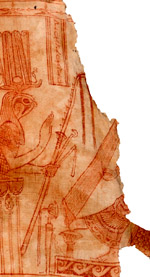Centre for Textile Research

Egyptian Textiles and Their Production: ‘Word’ and ‘Object’
Date of this Version
3-2-2020
Document Type
Book Chapter
Citation
Published in Maria Mossakowska-Gaubert, ed., Egyptian Textiles and Their Production: ‘Word’ and ‘Object’ (Hellenistic, Roman and Byzantine Periods) (Lincoln, NE: Zea Books, 2020).
doi 10.32873/unl.dc.zea.1090
Abstract
Ancient Kellis, modern Ismant el-Kharab is located in Dakhleh Oasis in Egypt’s Western Desert. The main occupation of the village was from the early to late Roman period (late 1st century to the beginning of the 5th century AD). Excavated as part of the Dakhleh Oasis Project, the site has revealed textual and archaeological evidence from which a detailed picture of life can be painted. To date, the main publications of the village’s finds have focussed on the textual remains, of literary and documentary texts in Coptic, Greek, and Syriac.1 A comparable publication of the archaeological evidence from the site is still pending, but the context of the surviving evidence is clear. Many of the documents were found in House 3, left there after the abandonment of the village around the turn of the 5th century, and reflect the concerns of several generations of its residents. One reason for the abundance of textual sources is the volume of written communication between individuals in Kellis and others in the Nile Valley, mostly members of the community who had travelled there for a variety of reasons. This Oasis–Valley duality is fundamental to understanding many of the documents, as well as the realities of life for Kellites. The distinction is made clear through reference to the Oasis (ⲟⲩⲁϩⲉ) and the Valley (“Egypt”, ⲕⲏⲙⲉ) and the importance of location will be raised at several points in the following discussion.
The Manichaean nature of the community, for which the texts are the primary evidence, has received the greatest amount of scholarly attention to date. Yet, there is vast potential for the examination of a range of topics, especially in conjunction with the surviving material remains. Examination of the domestic textile industry in Kellis holds particular promise. Possible routes of research include: the use of raw material, equipment (including matching the physical with the textual evidence), production techniques, organisation of work, gendered divisions in labour, the economic value and impact of textiles, local and national networks, and the religious use and role of textiles. Given the restricted scope of the current study, my intention is to provide a snapshot into the world of Kellis textiles and to demonstrate the potential for a complete study of textiles at the village. In order to do so, I look at three different areas: • The lexical study of textiles, both in Greek and Coptic. Concerning the latter, the Kellis material makes an important contribution in two respects: it significantly expands the chronologic and geographic range of our Coptic evidence, being among our earliest corpora of Coptic documents and located far from the Nile Valley. • The procurement of raw materials. Wool is used as a case study to highlight the range of evidence available and the different areas of life in the Oasis upon which light is shed. • The economy of textiles and textile production.
Included in
Africana Studies Commons, African Languages and Societies Commons, Classical Archaeology and Art History Commons, Fiber, Textile, and Weaving Arts Commons, History of Art, Architecture, and Archaeology Commons, History of Science, Technology, and Medicine Commons


Comments
Copyright © 2020 Jennifer Cromwell